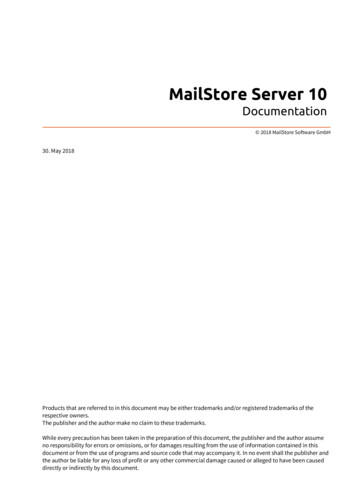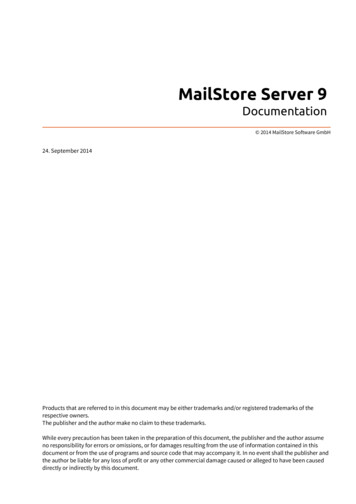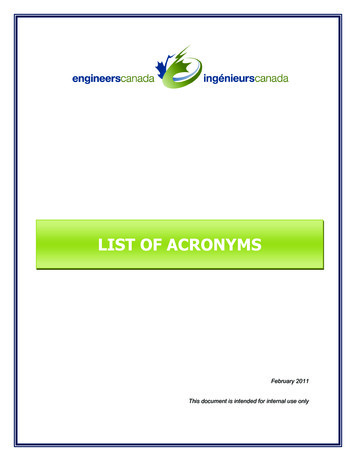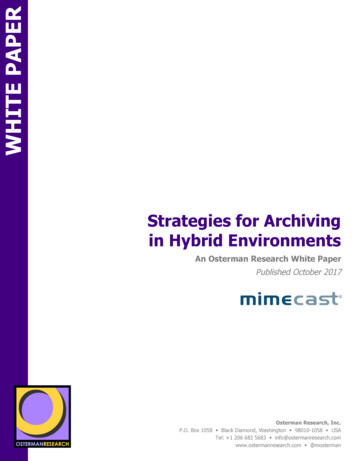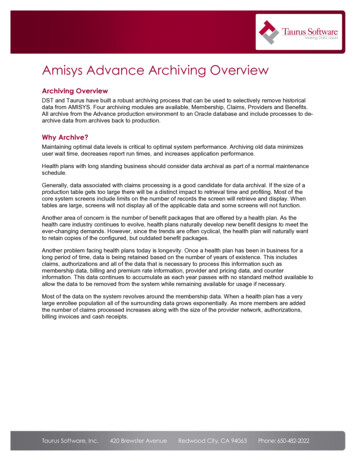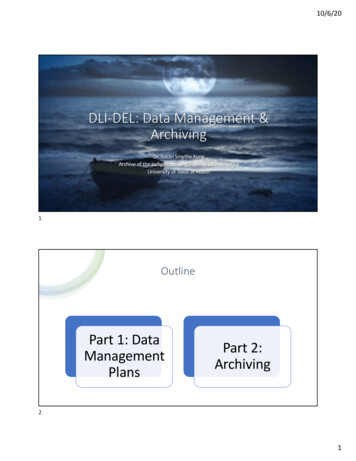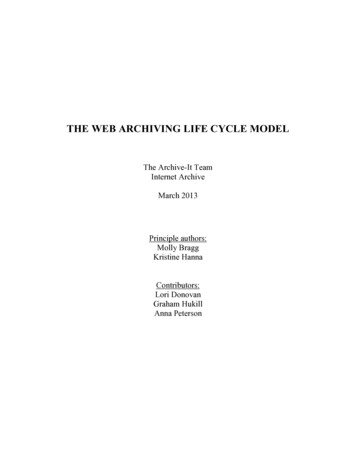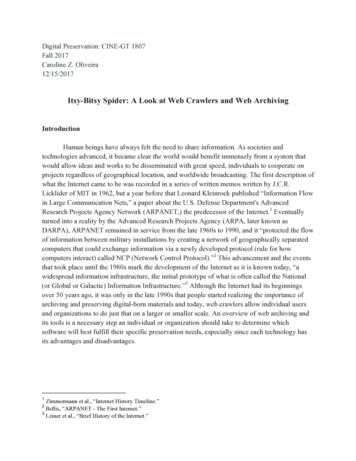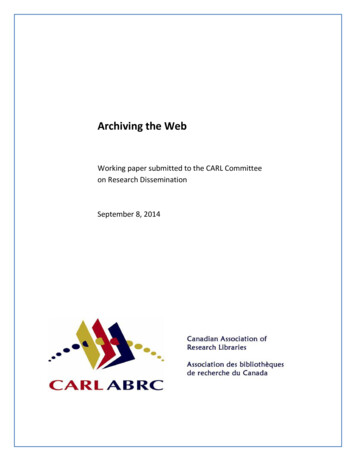
Transcription
Archiving the WebWorking paper submitted to the CARL Committeeon Research DisseminationSeptember 8, 2014
IntroductionIt is difficult to articulate the actual size of the web. It is vast and ever-changing as internet users theworld over constantly add, change and remove content. Amidst all that material is a great deal of globalcultural heritage being documented online. It behooves librarians, archivists and other informationprofessionals to preserve the Web, at least as much of it as possible, for future generations.In little over two decades, the Web has grown from being a relatively small service for scientists to anintegral part of everyday life at an unprecedented rate. It began as a communication and researchexchange hub for researchers and is now the pre-eminent global information medium everyonedepends on. More than serving as a massive source of information, the web also constitutes a uniquerecord of twenty-first century life of critical importance to current and future researchers. But the speedat which it develops, grows and transforms poses a definite threat to “our digital cultural memory, itstechnical legacy, evolution and our social history.” 1Research libraries have a vital role in helping to preserve parts of our historical and cultural legacy onthe web. In a published interview about the future directions of research libraries, University of TorontoLibrarian, Larry Alford, remarked on the types of fundamental library values that will likely endure:Libraries are still very much about acquiring materials and preserving them, regardless of theformat, so that they are still accessible hundreds of years from now. Many of the blogs andwebsites that led to the Arab Spring are now gone; they just disappeared. And yet pamphletsdistributed in Paris by various factions during the French Revolution still exist, stored in libraries.We in libraries must begin to acquire and preserve the “pamphlets” of the 21st Century – blogs,websites and other digital commentary on the events of our time. 2Identifying, capturing, describing, preserving and making accessible parts of the Web which documentthat collective commentary on the “events of our time” fits libraries’ mission to acquire, preserve andrender visible and accessible our accumulated knowledge, history and culture. Libraries have long beenin the business of preserving documentary heritage. That mission, which librarians have applied to bothprint and analogue audio visual media, equally applies to recorded knowledge and cultural expressionrecorded on the web. A key challenge is for libraries to nimbly adapt to constantly evolving webtechnology during a time of unprecedented change.Background and other reasons for archiving the WebThe Internet Archive has been crawling and preserving the web since the late 1990s, but otherorganizations’ involvement is crucial to the enterprise of web preservation. No single institution canrealistically hope to collect and piece together an archival replica of the entire web at the frequency anddepth that would be needed to effectively document entire societies’, governments’ and cultures’evolutions online. Only a hybrid approach, one that includes complimentary approaches involving thebroad crawls the Internet Archive regularly conducts paired with heritage organizations’ tackling of deepcurated collections by theme or site, can ensure that a truly representative segment of the web ispreserved for posterity. 31Pennock, Maureen, Web Archiving, DPC Technology Watch Report, 13-01, March 2013, Digital PreservationCoalition, p. 3 http://dx.doi.org/10.7207/twr13-012Anderson, Scott, Search and Discovery, University of Toronto Magazine, June 19, d/3Grotke, Abbie, Web Archiving at the Library of Congress, Computers in Libraries, Vol. 31 No. 10, December html2
Approaches to web archiving vary from bulk or domain (e.g. all the web pages of a particular country’sweb domain, Iceland (.is) or France (.fr), selective, thematic to event-based projects. For example, theLibrary of Congress Web Archive includes over 250 terabytes of data comprising various event andthematic web collections. 4 Library and Archives Canada manages the Government of Canada WebArchive. By 2005, LAC had harvested the web domain of the Government of Canada. The GC WAcontains over 170 digital objects comprising over 7 terabytes of data, though material harvested withcrawls since 2007 are is not publicly available currently. 5 Government-maintained websites and webarchives have high usage rates. Since 2009, Bibliothèque et Archives Nationales du Québec (BAnQ) hasendeavoured to create deep curated thematic archived web collections. As May 2014, six collectionscontaining web content about the 2012 provincial elections and the main political parties are accessiblefrom BAnQ’s website. 6 The UK Government Web Archive receives on average 100 million hits permonth. 7 The Danish National Web Archive takes a snapshot of “.dk” websites four times per year.Researchers can observe how the Internet has developed as a whole, in Denmark. The archive preservesvaried web material achieving a balance between text, images, and video content. 8Challenges to archiving the WebThere are other reasons for archiving the web aside from the imperative to preserve born digitaldocumentary heritage of social, cultural and historical interest. According to various estimates, theaverage life spans of web pages range from 44, 75 to 100 days. Specific content vanishes, often aspeople update pages and move or delete content to make way for more up-to-date information. Onecan even view broken links and “404 page not found” messages as the modern-day equivalent ofdocuments listed as “lost” in library catalogues but far more prevalent. Government agencies often havea legal obligation to preserve official records online. At this time the Canadian federal government is notlegally obligated to preserve government websites nor are provincial governments. Canada’s DepositoryServices Program (DSP) does collect PDFs from select agencies, there is not at present any organizationconducting deep harvests of that particular type of content, and much of it has disappeared. LAC istaking steps to remedy that situation. 9Organizations face social, legal and technological challenges to web archiving. The very pervasiveness ofthe web presents a problem insofar as we just take it for granted. Information is simply readily availablethrough a few keystrokes, inputting a query into a popular search engine, whenever we need it. Creatorsof web content do not necessarily create webpages and websites with preservation in mind. Frequentcrawls to harvest web content are important to have snapshots of the web over time. It is largely up tolibrarians, archivists and other information professionals to proactively capture historically and culturallyvaluable content before it is lost.Government information on the web presents a significant preservation challenge. With successiveparties’ governments coming into power and ceding it to their opponents or departments and agencies4Library of Congress, Web Archive Collections ollect 05Library and Archives Canada, Government of Canada Web ves/index-e.html6BAnQ, Archivage Web – curated collections: Coalition Avenir Québec (CAQ), Option nationale (ON), Parti libéraldu Québec (PLQ), Parti québécois (PQ), Parti vert du Québec (PVQ), Québec Solidaire (QS)http://www.banq.qc.ca/collections/archives web/?q &i &r Parti politique7Pennock, Maureen, Web Archiving, DPC Technology Watch Report, 13-01, March 2013, Digital PreservationCoalition, p. 3-4 http://dx.doi.org/10.7207/twr13-018Kuchler, Hannah, “How to preserve the Web’s past for the future,” Financial Times, April 11, 578-00144feabdc0.html#axzz30ZWsVFEy9Conversation with a member of the Canadian Government Information Private LOCKSS network (CGI-PLN)53
being shut down, replaced or merging with other entities or organization with different mandates, thepreservation of government information, reports and publications is by no means assured. Library staffat eleven institutions initiated the Canadian Government Information Private LOCKSS network October2012. 10 The CGI-PLN’s mission is to preserve digital collections of government information. Preservationentails that digital research materials remain accessible across geographically dispersed serves.Protection measures against data loss forward format migration are among the actions this group willperform to steward government information in Canada.Four operating principles guide the CGI-PLN’s work: Commitment to the long-term preservation of government informationApplication of the LOCKSS digital preservation software for preserving and replicating content insecure distributed serversOngoing exploration of new digital preservation technologies and best practicesLow-cost, sustainable preservation strategies that maintain sufficient capacity to accommodatelarge digital collectionsA steering committee oversees the CGI-PLN’s work. And a technical sub-committee advises the steeringcommittee on technology and network capacity. Overall, it is a dispersed but highly motivated group.Members communicate frequently over e-mail and a collaborative group wiki. The steering committeemeets on a quarterly basis. This initiative seeks to provide no-fee access to digital collections ofgovernment information that are “deemed to have enduring value” and include information from andabout government, inter-governmental agencies, and non-government organizations. The targetedmaterials are publications or any digital content that federal or provincial departments or agenciesproduce. The CGI-PLN also intends to include digitized collections of government information andpublications that member institutions host. 11Aside from problems owing to oversight or inertia, conflict also presents a significant threat the survivalof archival, museum and library collections in areas of the world affected by war and political instability.The content on the Web is also vulnerable in such cases. A group of investigative reporters working inthe Crimea, a contested area which has led to tense relations between the Ukraine and Russia in 2014,turned to the Internet Archive to safeguard their group’s web pages and reports. The Crimean Centre forInvestigative Journalism feared its reports could be taken off the internet at any moment given currentcivil unrest occurring in the Crimea. They entered the web addresses of their webpages and reportsthereby “freezing the pages in time” and ensuring they collected new records each day. 12The legality of web archiving initiatives poses another significant non-technical challenge. Does aninstitution have the right, legally, to provide access to copies of web content independently of theoriginal site and without the explicit consent of the owner or content creator? Can archiving webcontent in such cases constitute a breach of a site owner’s copyright? That can depend on the countryconcerned or the collecting institution’s remit. Use of Creative Commons licences and crown copyrightcan provide some clarity.10The CGI-PLN’s member institutions are: University of Alberta, Simon Fraser University, University of BritishColumbia, University of Calgary, University of Saskatchewan, University of Victoria, McGill University, DalhousieUniversity, Scholars Portal, University of Toronto, Stanford University, and the Legislative Assembly of Ontario.11CGI-PLN http://plnwiki.lockss.org/wiki/index.php/CGI network12Kuchler, Hannah, op cit.4
UK legal deposit legislation allows for selective, permissions-based web archiving coordinated at theBritish Library. The UK Archives’ web preserving activity is smaller in scope; it has clear statutorypermission to archive and provide access to crown-copyrighted material stemming from a legal mandatefrom the Public Records Act. In the US, the Library of Congress carries out much of its web archivingwork on a permissions basis. The Internet Archive, without any explicit legislative mandate, operateslargely on a “silence is consent” approach taking archived material down should the content ownerrequest it. Other countries use legal deposit mechanisms but may opt to restrict access to readingrooms or even make use of “dark archives.” 13 Whichever the approach organizations take to webarchiving, they need to consider data protection and citizens’ privacy rights as well. 14Different types of Web archivingThere are three types of large-scale web archiving: client-side archiving; transactional archiving; andserver-side archiving. 15Client-side archiving is scalable and cost-effective with little input required by web content owners.Other characteristics: Involves use of web crawlers such as Heritrix or HTTrack which act like browsers using the HTTPprotocol and gather content delivered from serversCrawler follows a seed instruction, crawls all links associated with the seed to a specified depth,captures copies of all available filesTransactional archiving is intended to capture client-side transactions rather than directly hostedcontent. Other characteristics: Supports growth of more comprehensive collectionsEnables user access recordingRecords client/server transactions over timeRequires implementing code on the server hosting the content, and is more often used bycontent owners or hosts than external web content collecting agenciesDirect server-side archiving requires active participation from publishing organizations or the contentowners. Other characteristics: Entails copying files from a server without using the HTTP protocolThere are potential issues when it comes to generating working versions of websites – e.g. whentrying to recreate a similar hosting environment to that of the original live site; this can be thecase with database-driven websitesThis approach can be good for capturing content crawlers miss13Dark archive: “(n.) In reference to data storage, an archive that cannot be accessed by any users. Access to thedata is either limited to a set few individuals or completely restricted to all. The purpose of a dark archive is tofunction as a repository for information that can be used as a failsafe during disaster recovery.” Webopediahttp://www.webopedia.com/TERM/D/dark archive.html14Pennock, Maureen, Web Archiving, DPC Technology Watch Report, 13-01, March 2013, Digital PreservationCoalition, p. 10 http://dx.doi.org/10.7207/twr13-0115Ibid, p. 75
It bears noting that web crawlers have their limitations. They can encounter difficulty in harvestingcontent from database-driven websites, streamed audio-visual files, certain java-scripted contents, andthey cannot crawl the deep web’s password-protected content. 16Quality controlQuality control is another important consideration for web archiving. Archivists’, librarians’ and otherinformation professionals’ curatorial role is needed to catch potential biases of web content, unfoundedclaims or even outright nonsense present in some content. Research and development may yield betterweb crawling technologies able to discern junk content from that which is valuable for research, butthere will arguably always be a need for individuals to appraise web content in some capacity.Web archiving in CARL and other librariesVarious CARL libraries have partnered with the Internet Archive, and are undertaking other webarchiving initiatives. Some of the challenges they have to address have to do with staffing and resourcelimitations. An environmental scan the University of Alberta Libraries Digital Initiatives Unit conductedwith a number of American university libraries and a few state libraries in 2011 is illustrative of theconstraints most libraries must work within as they embark on web archiving projects.The respondents reported that they did not have official procedures. Most employed “ad hoc”approaches for web archiving because of a shortage of full-time staff to do the work. In order to capturecollections of time-sensitive and broad-in-scope web content, some institutions preferred to automatemany of their processes. Most web archiving projects require the attention of 1 to 3 professional staffand 1 or 2 student assistants. State libraries mandated to preserve and provide access to governmentinformation and documents to the web can often allot more staff and time web archiving projects. Therespondents of the University of Alberta Libraries’ environmental scan relied mostly on Archive-It. Theyused Archive-It webinars for training purposes and sought personal assistance from Archive-It staffwhen needed. Some institutions can be limited in what they can realistically accomplish in this areahaving only one FTE whose attention is already divided among a number of priority areas in their work. 17In practical terms, at least one staff member with subject knowledge will select URLs but, depending onthe size of the project, that individual might need to collaborate with other colleagues or hire studentassistants to help carry out the work of building the collection. The same URL selectors assign metadatafor pages in archived web collections independently or with in consultation with other colleaguespossessing the required subject expertise. Student assistants sometimes receive some training to inputmetadata as well. 18University of Alberta Libraries, Simon Fraser University Library, UBC Library, University of ManitobaLibraries, University of Saskatchewan Library, University of Victoria Libraries and the University ofWinnipeg Library participate in a COPPUL (Council of Pacific and Prairie University Libraries) Archive-Itlicensing deal. 19 Offered by the Internet Archive, Archive-It is a web-based application that enablesusers to build, manage, preserve and provide access to collections of web content. It is a fully hostedsubscription service that also offers collection development tools for scoping, selection, and metadata16Anthony, Adoghe, Web archiving: techniques, challenges, and solutions, International Journal of Managementand Information Technology, Vol. 5 No. 3, September 2013, p. /view/53212317Lau, Kelly E., University of Alberta Born Digital Working Group Environmental Scan for Archive-It PartnerInstitutions Report, September 2012, p. 418Lau, Kelly E., op cit., p. 619COPPUL, Archive-It Participants http://www.coppul.ca/dbs/view.php?dbid 2146
input for cataloguing among others. Users are able to choose from 10 different web crawl frequencies.The archived content of collections using Archive-It includes HTML, PDFs, images and other documentformats. Captured content is browsable within 24 hours after being archived, and it is possible to run fulltext searchers within 7 days. 20The way the software works is: Archive-It crawls websites and copies the information and the filesembedded on selected websites. More specifically, it begins with specified seed URLs, it verifies thatURLs are accessible and archives them. The crawler software checks the embedded contents (CSS,JavaScript, images, etc.). Archive-It searches for links to other webpages and archives them when theyare in scope. A crawl continues until there are no more in-scope links and pages to capture or it reachesthe maximum time allotted for the crawl or reaches a specified data limit. 21This service already supports metadata importing, restricted access to certain addresses and passwordprotection if necessary, and in browsing quality assurance. And first quarter updates for 2014 supportcapture of media-rich web content including social media. The most recent update also includesvisualization tools for analyzing archived collections. 22 For institutions with limited staffing andresources to bring to bear on web preservation projects, Archive-It is a reliable option developed by theInternet Archive – a non-profit (funded largely by research libraries and private donations) that focussessolely on preserving as much of the web as possible for future generations. Collaboration from ArchiveIt-subscribing libraries, however, is key complementing the Internet Archive’s broad crawls and contentcaptures with deeper curated collections. Both kinds of work will help ensure a more complete pictureof the Web’s legacy for future researchers.The following two vignettes provide brief summaries of what the scope of a Canadian research library’sweb archiving activity might look like at this time.University of Alberta LibrariesAs stated on its website, University of Alberta Libraries uses Archive-It “to collect web content ofimportance to the U of A community that is at risk of being lost, deleted, or forgotten over time.” Thelibrary currently provides access to 15 thematic collections of archived web content including the June2013 Alberta floods, the Alberta Oil Sands, an energy/environment collection, the Idle No Moremovement, Canadian business grey literature collection, and Canadian health grey literature amongothers. The collections comprise web material of enduring value and cover important regional events orissues. For example, June 2013 saw some of the worst flooding in Alberta's history, with areas in thesouthern portion of the province being most affected. The Alberta Floods June 2013 collection captured165 websites that detail the events as they happened, their impact on communities, and the recoveryefforts. The Prairie Provinces Politics & Economics collection captures sites related to the CanadianPrairie Provinces’ politics, economics, society, and culture. The collection focuses on Alberta though italso covers of Saskatchewan and Manitoba. La francophonie de l'ouest canadien / Western CanadianFrancophonie is another Archive-It collection UAL is developing, it archives websites chronicling life inthe four Prairie Provinces’ francophone communities. 2320Reed, Scott, Archive-It: a web archiving service of the Internet Archive since 2006, presentation at the 2013conference of the Association of Canadian Archivists21Ibid22Ibid23University of Alberta Libraries, Archive-IT collections, https://archive-it.org/organizations/4017
Bibliothèque et Archives Nationales du Québec (BAnQ)Since 2009, BAnQ has been selectively archiving websites created in the province of Québec. As ofSeptember 2014, the library has preserved 39 collections covering the 2012 provincial election, 2013municipal elections, political parties in the province, captures of various Quebec cities’ and towns’websites, and two more governmental websites: the National Assembly, and the Ministry of Municipaland Regional Affairs. This particular collection of archived web content has grown fairly quickly, fromjust about a half dozen sites, in May 2014, to 39 just four months later. BAnQ makes every effort tomaintain the original design and structure of the content as it was originally created. That being thecase, the library still places a brief disclaimer to the effect that, although the essential design andinformation architectures of the preserved sites remain largely intact, the user may still encounter someanomalies when consulting these particular digital collections. 24Survey – Archiving the WebOver the summer, the CARL office polled the membership with just one question: whether or not itsmember libraries have embarked on any kind of web archiving projects. Based on the informationresponses received, a subset of 14 libraries (including a non-CARL institution) was sent a follow-upsurvey comprising just five questions (See Appendix 2). The questionnaire 25 was intended to provide ageneral picture of the kinds of activities CARL libraries are pursuing in developing collections of contentcaptured from the open web. Only four libraries responded, for a response rate of 28%. The resultingsmall sample, can only give an approximate impression of what Canadian research libraries are doingaround web archiving. Appendix 1 shows the aggregated survey responses.All four responding libraries are currently undertaking web archiving work to support research andteaching at their institution. They capture, describe, and make the content discoverable in a fewdifferent ways. It is not possible to convey the full scope of the kinds of web material preserved. Oneparticipant indicated that their library is focusing its efforts on various Government of Canada websites.Three harvest content using Archive-It, and the other employs the Heritrix web crawler and Wget.The number of staff who devote some of their time to web archiving projects is limited. Two librarieseach have one staff member involved in this work, one has five, and the other respondent indicated thatsubject specialist librarians carry out the work with the assistance of support staff and technical servicesstaff (both as needed), but did not specify how many staff members are involved and remarked that theweb archiving-related activities “are only one small portion of the work of all these individuals”.One responding library is carrying out the work internally, another has engaged several faculty members“to help build subject-specific collections”, another has collaborated with a few academic staff who havean interest in web archiving. The latter is also exploring opportunities to pursue further webpreservation with the library school at their institution as components of one or more classes – e.g.collection development, digital preservation, etc. The fourth responded is involved in collaborative GoCwebsite harvesting at the national level with several libraries. The nature of web archiving work typicallyrequires that it be done collaboratively.24Bibliothèque et Archives Nationales du Québec (BAnQ), Archivage Webhttp://www.banq.qc.ca/collections/collections patrimoniales/archives web/index.html?q &r Gouvernemental25Survey questionnaire adapted from Abbie Grotke, Web Archiving at the Library of Congress, andrevised with feedback from the University of Alberta Libraries (with CARL’s appreciation).8
In terms of cataloguing captured web content, approaches among the respondents seem to vary: fromusing the Islandora Web ARChive Solution Pack, applying Dublin Core metadata, exploring how the datamight be rendered discoverable in a discovery layer using OAI-PMH, to having full catalog recordscreated through the integrated library system (ILS) at the document, seed and collection level. Thesurvey participants enable browsing and searching of web collections using features provided byArchive-It or the Islandora Web ARChive Solution Pack. One library’s browsing and searching solution isstill in development. These solutions also appear to integrate with other digital collections and variousfinding aids. One respondent said that their library has created a webpage that provides searchfunctionality across all the web archive collections created so far.It is still very much the early days for this kind of work, preserving select content from the open web.The COPPUL collaborative approach, using Archive-It, and the Canadian Government Information PrivateLOCKSS Network are two good collaborative models libraries can continue to work from to helppreserve important research, historical and cultural information that is currently at risk of being lost.9
Works citedAnderson, Scott, “Search and Discovery”, University of Toronto Magazine, June 19, d/Anthony, Adoghe, Web archiving: techniques, challenges, and solutions, International Journal ofManagement and Information Technology, Vol. 5, No. 3, September e/view/532123Canadian Government Information Private LOCKSS network CGI networkGrotke, Abbie, Web Archiving at the Library of Congress, Computers in Libraries, Vol. 31 No. 10,December 2011 Kuchler, Hannah, “How to preserve the Web’s past for the future,” Financial Times, April 11, 578-00144feabdc0.html#axzz30ZWsVFEyLau, Kelly E., University of Alberta Born Digital Working Group Environmental Scan for Archive-It PartnerInstitutions Report, September 2012Pennock, Maureen, Web Archiving, DPC Technology Watch Report, 13-01, March 2013, DigitalPreservation Coalition, p. 3 http://dx.doi.org/10.7207/twr13-01Reed, Scott, Archive-It: a web archiving service of the Internet Archive since 2006, presentation at the2013 conference of the Association of Canadian Archivists10
Respondent1.) Describe yourorganization's current webarchiving activities.Include, at a minimum, thefollowing information:Summary of activitiesWhat web archiving toolsare used to harvestcontent?How many of your staffmembers are involved inthis work?1Building collections inArchive-it to supportresearch and teaching.Most crawls are not yetpublically available as wesort out permission issues,etc., with university lawyer2Archive-it3We have been involved inweb archiving since 2009,seeing this as a componentof our collectiondevelopment activities. Wearchive relevant webcontent, providedescriptions, and make itdiscoverable in a variety ofways.Appendix 1 – Survey questionnaire: Archiving the webCapturing, preserving, anddisseminating websites.Archive-it5Heritrix and/or Wget1Work to develop andmaintain collections iscarried out by subjectlibrarians with supportstaff assistance, descriptivework is carried out bylibrarians and support staffin bibliographic services,technical support andtraining for those involvedis shared among a smallgroup of support staff.These web archivingrelated activities
Challenges to archiving the Web There are other reasons for archiving the web aside from the imperative to preserve born digital documentary heritage of social, cultural and historical interest. According to various estimates, the average life spans of web pages range from 44, 75 to 100 days. Specific content vanishes, often as


